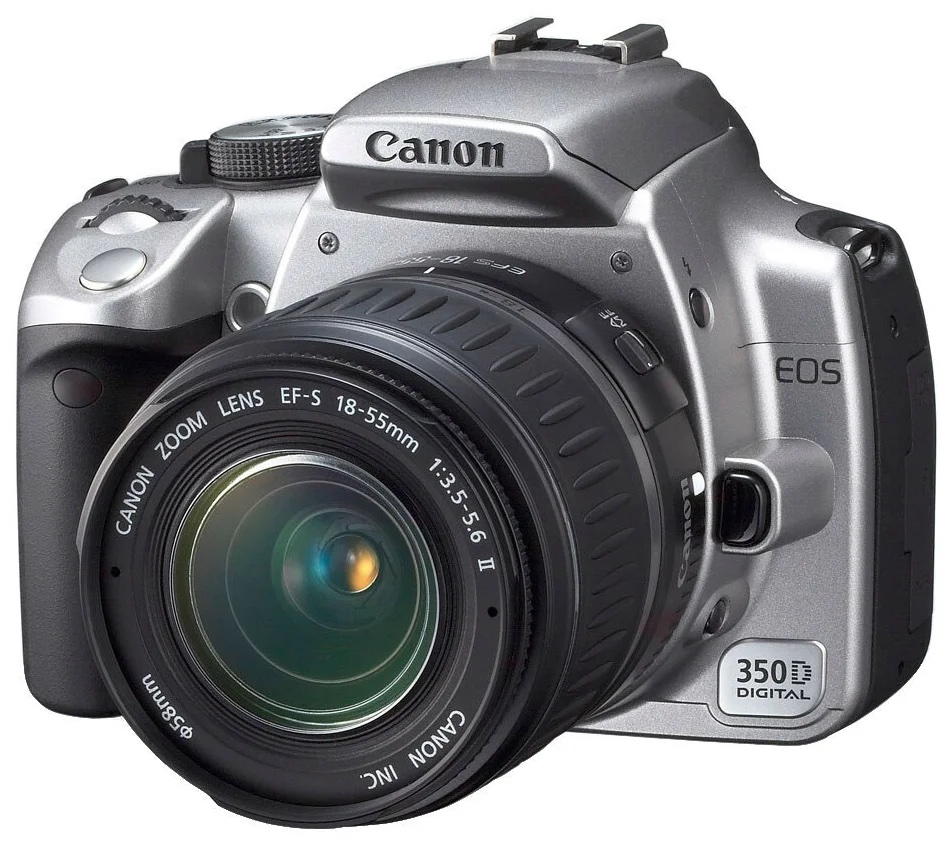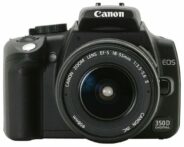Canon EOS 350D
aka Canon EOS Digital Rebel XT
aka Canon EOS Kiss Digital N
APS-C AF digital SLR camera
Specification
| Production details: | |
| Announced: | February 2005 |
| System: | ● Canon EOS APS-C (2003) |
| Format: | |
| Maximum format: | APS-C |
| Imaging sensor: | 22.2 × 14.8mm CMOS sensor |
| Resolution: | 3456 × 2304 - 8 MP |
| Crop factor: | 1.62x |
| Sensor-shift image stabilization: | - |
| Mount and Flange focal distance: | Canon EF-S [44mm] |
| Shutter: | |
| Type: | Focal-plane |
| Model: | Electronically controlled |
| Speeds: | 30 - 1/4000 + B |
| Exposure: | |
| Exposure metering: | Through-the-lens (TTL), open-aperture |
| Exposure modes: | Programmed Auto |
| Aperture-priority Auto | |
| Shutter-priority Auto | |
| Manual | |
| Physical characteristics: | |
| Weight: | 485g |
| Dimensions: | 126.5x94.2x64mm |
Manufacturer description
Amstelveen, The Netherlands, 17 February, 2005 - Canon, a leader in photographic and imaging technology, today upgrades the EOS 300D with the 8.0 Megapixel, 3 frame per second EOS 350D Digital. The launch completes a refresh of the entire digital EOS line-up and confirms Canon’s commitment to digital SLR research and development.
“The EOS 300D kick started the digital SLR revolution, becoming the best selling model of all time, ” the EOS 350D Digital will now take over, playing a major role in Canon’s digital SLR strategy,” said Mogens Jensen, Head of Canon Consumer Imaging Europe. “Canon predicts the D-SLR market will double in size by the end of 2006.”
The EOS 350D Digital features a newly developed, second generation, extremely low noise APS-C size 8.0 Megapixel CMOS sensor – the fourth new CMOS sensor from Canon in just twelve months. It is powered by the same DIGIC II image processor found in Canon’s professional series D-SLR cameras, and features 3 frame per second, 14 frame burst operation, USB 2.0 Hi-Speed interface, simultaneous RAW and Large JPEG writing and 0.2 second start up time. The camera is more than 10% lighter and 25% smaller by volume than the EOS 300D. It is available in both black and silver finishes.
“The camera combines ease of use with many of the same compelling technologies found in Canon’s professional series EOS cameras, chosen by more than 70% of pro photographers at the 2004 Athens Olympics, ” observed Jensen. “For the first time, every camera in the EOS digital range now incorporates a Canon original CMOS sensor and Canon DIGIC II processor.”
In terms of speed and resolution, Canon now has the leading performance camera in every D-SLR segment; all launched since January last year:
- EOS-1Ds Mark II - 16.7 Megapixel full frame 35mm sensor, 4 fps
- EOS-1D Mark II - 8.2 Megapixel APS-H size sensor, 8.5 fps
- EOS 20D - 8.2 Megapixel APS-C size sensor, 5.0 fps
- EOS 350D Digital - 8.0 Megapixel APS-C size sensor, 3.0 fps.
Target user
With plain language menus, intuitive controls and default settings chosen to reflect general every-day use, the EOS 350D Digital is designed to appeal to digital still compact users looking to expand their creativity, and film SLR users who have been waiting for 8.0 Megapixel performance at this price point. It will be available as body only and in kit form with the new EF-S 18-55mm f/3.5-5.6 II lens.
Improvements over the EOS 300D
The new CMOS sensor and high performance DIGIC II performance lead a number of improvements to the EOS 300D. Other advances include E-TTL II distance-linked flash metering for easy, consistent and precise flash exposures. Users can now select between three focus modes: One-Shot AF, AI SERVO and AI Focus. Writing to memory card is 3.5 times faster and the interface is upgraded to USB 2.0 Hi-Speed for fast image downloads. Mirror lock-up and 2nd curtain flash have also been added.
The camera now features the same Monochrome mode found on the EOS 20D, allowing users to shoot in black & white with a range of filter effects. White Balance correction of both blue/amber and magenta/green bias is available to ±9 levels and WB bracketing is extended to include the magenta/green bias direction. Digital Photo Professional RAW image processing software – the same professional workflow software supplied with Canon’s €8,000 EOS-1Ds Mark II, has been added to the standard supplied software.
Low noise sensor and precision optics
The CMOS sensor features redesigned pixel sites, with improved capacity to isolate any residual charge remaining after the pixel site is reset. This is then subtracted from the exposure to suppress any random pattern noise. Improvements in image quality are particularly noticeable with long shutter exposures and high ISO settings, and result in more even rendering of uniform surfaces, such as blue skies. The low noise of the second generation CMOS sensor delivers clean images from ISO 100 through to ISO 1600.
The APS-C size sensor gives the camera a 1.6x magnification compared to 35mm cameras. The camera’s EF-S lens mount works seamlessly with all of the more than 60 Canon EF lenses – the world’s largest interchangeable lens system. It is also compatible with the four EF–S lenses developed for Canon’s APS-C format digital SLRs (the EOS 20D and EOS 300D) including the new EF-S 60mm f/2.8 Macro USM lens.
Faster processing for better results
Underpinning the camera's performance is Canon's high-speed DIGIC II (Digital Image Core) processor, as found in Canon’s professional series EOS-1D Mark II and EOS-1Ds Mark II. DIGIC II is Canon’s second generation image processor, purpose built to handle the complex algorithms required for maximum image quality; optimally processing functions such as white balance and colour rendition. By integrating key functions onto a single processor, DIGIC II delivers superb quality images without trading camera responsiveness. "Digital image quality is dependent on three factors: lens quality, sensor performance and image processing capability,” said Jensen. “Canon is a developer, designer and manufacturer of the key components in each of the three critical technology areas: lens, CMOS sensor and image processor. It is the leadership position in each of these core technology areas that gives the EOS 350D Digital its edge.”
Better focusing
Focus can now be selected between One Shot AF (for single shot focusing), AI SERVO AF (for predictive tracking of subjects approaching at up to 50kph up to 10m away ) and AI Focus AF (switches automatically between One Shot AF and AI SERVO AF when subject movement is detected). This improves on the EOS 300D by providing direct selection of the three focusing modes. For more flexible focusing, AF point selection is now possible with the cross keys as well as from the main dial. Full time manual override is available with all EF Auto Focus lenses, while a new Precision Matte screen gives a brighter viewfinder image for easier, more accurate manual focusing.
Improved flash
The pop-up flash has a guide number of 13 and sits even higher (95.5mm) above the optical axis than on the EOS 300D, helping suppress red eye effect and reducing the possibility of lens barrel shadow. Angle of coverage extends to support wide lenses to 17mm. Flash compensation of ±2 stops in 1/3- or 1/2- stop increments is available with both the built-in flash and with all EX-series Speedlite flash units.
Print and review
Lab-quality prints can be produced without the need for a computer by directly connecting the EOS 350D Digital to any PictBridge compatible photo printer via the supplied USB cable. The new USB 2.0 Hi-Speed connection improves computer upload times, and is also compatible with USB 1.1 and Picture Transfer Protocol (PTP) for driverless transfers.
The 1.8" LCD is used to select and review photographs to be printed and set print variables. During image playback, it is possible to jump forward or back by date, by single image, or by groups of 10 or 100 images. Review display modes have been extended, making it possible to review an image without overlaying any information.
High-end exposure control
The EOS 350D Digital retains the accurate 35 zone TTL metering of the EOS 300D. The three metering modes (evaluative, partial, and centre weighted average) are now manually selectable and both exposure compensation and exposure bracketing are available in 1/2 stop increments as well as the 1/3 stop increments of the EOS 300D. The EOS 350D Digital retains the popular Programmed Image Control modes of the EOS 300D, such as Night Portrait, Sports, Close-up, Landscape, Portrait and Flash OFF.
Shooting adaptability
Shutter speeds extend from 30 sec to 1/4000 sec, plus bulb and high-speed x-sync at 1/200s. The memory card slot supports 2GB and higher CompactFlash Type I and II cards. Optional wired or infra red wireless remote control is available. Seven preset White Balance settings (such as cloudy, tungsten, fluorescent, etc.) plus custom White Balance and ±3 stop White Balance Bracketing (WB-BKT) ensure that image colours match the photographer’s recollection of the scene.
Comprehensive accessories, software and online access
The EOS 350D Digital comes complete with NB-2LH battery pack, charger, USB cable, video cable, wide embroidered anti-slip neck strap. A new optional Battery Grip BG-E3 gives the camera a solid and balanced pro feel, particularly when the camera is fitted with longer lenses, and includes a shutter release and main dial for vertical/portrait shooting. It comes complete with one magazine that takes 6 AA batteries and another that takes two NB-2LH Li-Ion rechargeable batteries.
Purchase of the EOS 350D Digital entitles photographers to membership of the CANON iMAGE GATEWAY with a 100 MB online photo album for image uploads. As well as Digital Photo Professional RAW image workflow software, ZoomBrowser EX 5.1 (Windows) and ImageBrowser 5.1 (Mac) are included for handling image file transfers between camera and computer, managing and printing files, and preview and conversion of RAW images. PhotoStitch is included for seamless merging of panorama shots. Arcsoft PhotoStudio software allows artistic and creative manipulation of images.
Table of contents
Clickable
Instruction manual
Clickable
Canon EOS APS-C system cameras
Clickable
- Canon EOS 1000D
- Canon EOS 100D
- Canon EOS 1100D
- Canon EOS 1200D
- Canon EOS 1300D
- Canon EOS 2000D
- Canon EOS 200D
- Canon EOS 20D
- Canon EOS 250D
- Canon EOS 300D
- Canon EOS 30D
- Canon EOS 350D
- Canon EOS 4000D
- Canon EOS 400D
- Canon EOS 40D
- Canon EOS 450D
- Canon EOS 500D
- Canon EOS 50D
- Canon EOS 550D
- Canon EOS 600D
- Canon EOS 60D
- Canon EOS 650D
- Canon EOS 700D
- Canon EOS 70D
- Canon EOS 750D
- Canon EOS 760D
- Canon EOS 77D
- Canon EOS 7D
- Canon EOS 7D Mark II
- Canon EOS 800D
- Canon EOS 80D
- Canon EOS 850D
- Canon EOS 90D

